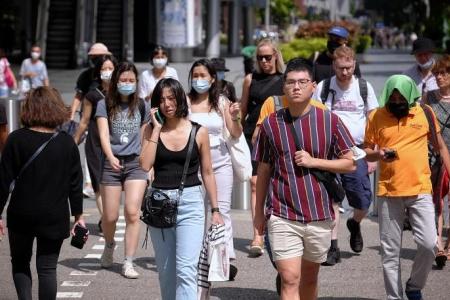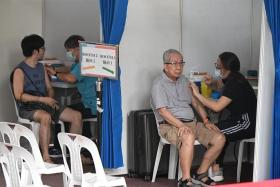2022: The year masks came off in Singapore
As 2022 draws to a close, it will probably be best remembered as the year people in Singapore took their masks off. This came after more than two years of having to mask up every time they left home, unless they were exercising outdoors.
During the two years of being weighed down by Covid-19 restrictions, people also had to work or study at home, limit the number of visitors they could host and prove their vaccination status when entering shopping malls.
The masks were the most visible symbol of these curbs. Many were relieved when, in end-August, they were no longer required to wear them except while taking public transport or at healthcare facilities. The other measures were rolled back by October.
Life has largely reverted to normal, with people frequenting restaurants and theatres, travelling and returning in person to work and school.
Nevertheless, the pandemic has left its mark.
The coronavirus is still spreading in the country, and some who are infected still need intensive care, or even die from the disease.
Today, 82 per cent of residents have received the minimum vaccine protection as defined by the Ministry of Health – that is, either three doses of an mRNA or Novavax vaccine or four doses of a Sinovax vaccine.
People who had received their minimum protection less than five months ago, or who have taken one more booster shot, are part of the 65 per cent defined as being up to date with their Covid-19 vaccination.
Risk of death for people who are up to date with their vaccination is significantly lower than for people who do not even have the minimum protection.
For every 10,000 infections among people with no minimum protection, 70 either die or require treatment in the intensive care unit (ICU). Compared with the country’s population as a whole, this falls to just five deaths or ICU cases per 10,000 infections.
Unfortunately, even with maximum vaccine protection, some people, especially those who are older and also suffer from chronic medical conditions, can still die from getting Covid-19.
Hence, the need to continue wearing masks on public transport and in healthcare facilities, to protect people at risk of severe illness who may get infected. They are vulnerable on public transport because of the confined space, and in hospitals and other medical facilities because of the high proportion of sick people.
Meanwhile, hospitals are grappling with a surge in surgical operations that had been postponed at the height of the pandemic, when hundreds of hospital beds were reserved for Covid-19 patients. Not surprisingly, patients who need treatment that were non-critical – such as knee replacement – want them done soonest.
It will take some time to clear this backlog of cases. Hopefully, it will happen before the end of 2023 – unless Covid-19 rears its head again.
The pandemic is not yet over, with about half a million new cases and 1,000 to 2,000 deaths reported each day, globally.
Earlier in December, Health Minister Ong Ye Kung warned of a possible new wave as people mingle more for year-end celebrations and also as more people travel, including to countries where winter increases the risk of infection.
Singapore has seen several waves of Covid-19 surges, from the original wild type, to Delta and Omicron, including the XBB strain.
To date, more than 1,700 people have died from the coronavirus infection, and more than two million have been documented as having been infected. The real infection rate could be double that, say experts. There are people who have been infected more than once.
The Omicron variant now accounts for more than 98 per cent of all reported cases globally. But this is not as reassuring as it might sound. That is because Omicron infection is not homogenous. In fact, the World Health Organisation has listed five Omicron offshoots as “Omicron subvariants under monitoring”.
It has done this, it says on its website, “in light of the widespread transmission of the Omicron variant of concern across the globe and the subsequent expected increased viral diversity”.
This year alone, Singapore has seen three Omicron waves: the BA.2 wave peaked here in March, the BA.5 sparked a wave in June and July, and Singapore is just over the XBB wave which hit in October and November.
While the bivalent vaccines now given as boosters here also include an Omicron strain, they do not protect equally against all variants. Fortunately, the vaccines do provide a good, though not foolproof, shield against severe illness and death.
So while Singapore has essentially moved towards treating Covid-19 as endemic, it cannot let its guard down. It is still possible that the nation could see a variant against which the current vaccines are not very effective.
It is perhaps timely, as the year draws to a close, to recall the New Year message from Prime Minister Lee Hsien Loong at the start of 2022.
He said: “We have been grappling with Covid-19 for two years now. It has been a long and hard fight. We undertook drastic measures to protect lives and livelihoods. We closed our borders for the first time in our history. We drew heavily on our past reserves to support workers and businesses. We innovated and adapted quickly to new ways of living, working and learning.
“As a result, we kept our healthcare system resilient and prevented significant loss of lives. Government Budgets saved jobs and nursed the economy back to health. At every step of the way, Singaporeans mustered strength and resolve to support one another.
“Many went above and beyond the call of duty. Our front-line and healthcare workers especially have worked tirelessly round the clock. Businesses and everyday heroes, often in less visible places, have displayed courage and public spirit, and kept Singapore going and everyone safe.”
As we move into 2023, we should continue to do our best to ensure that the more vulnerable are not infected. We can do this by staying home when sick, and masking up where appropriate. Seniors, for example, can wear masks in crowded places.
Such behaviour is part of the culture in places like Japan. We, too, should adopt it and keep it even after the pandemic has passed.
Get The New Paper on your phone with the free TNP app. Download from the Apple App Store or Google Play Store now


